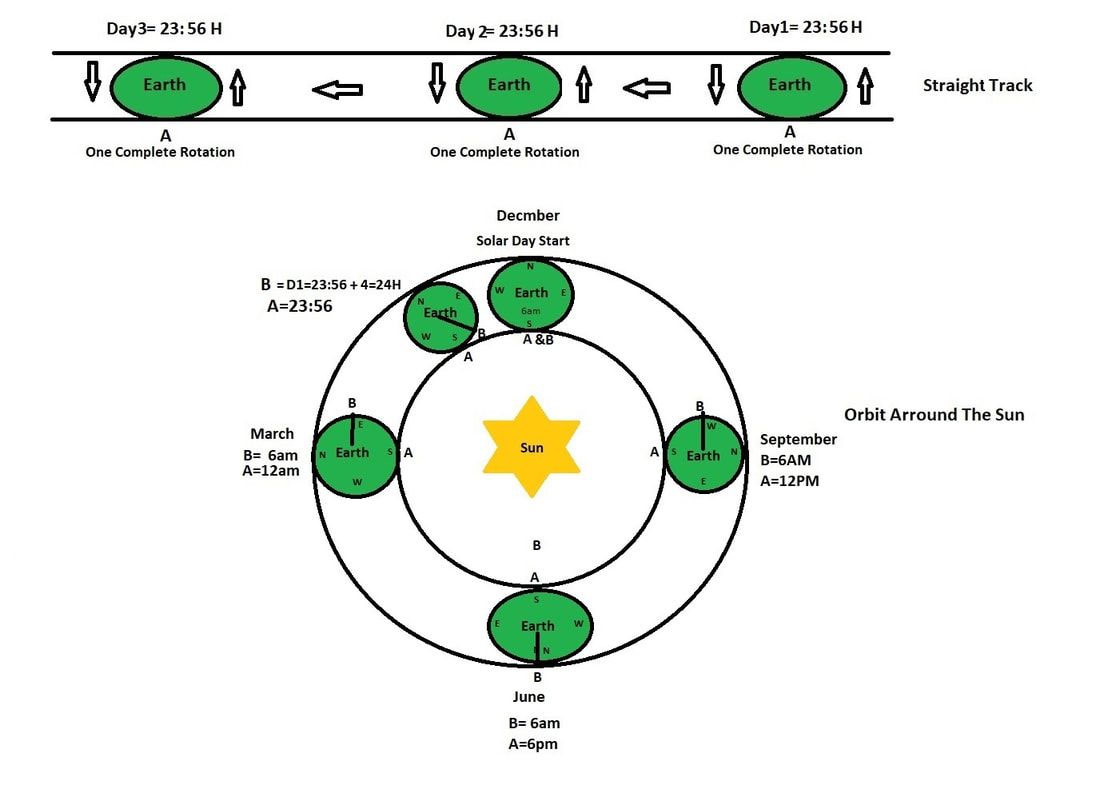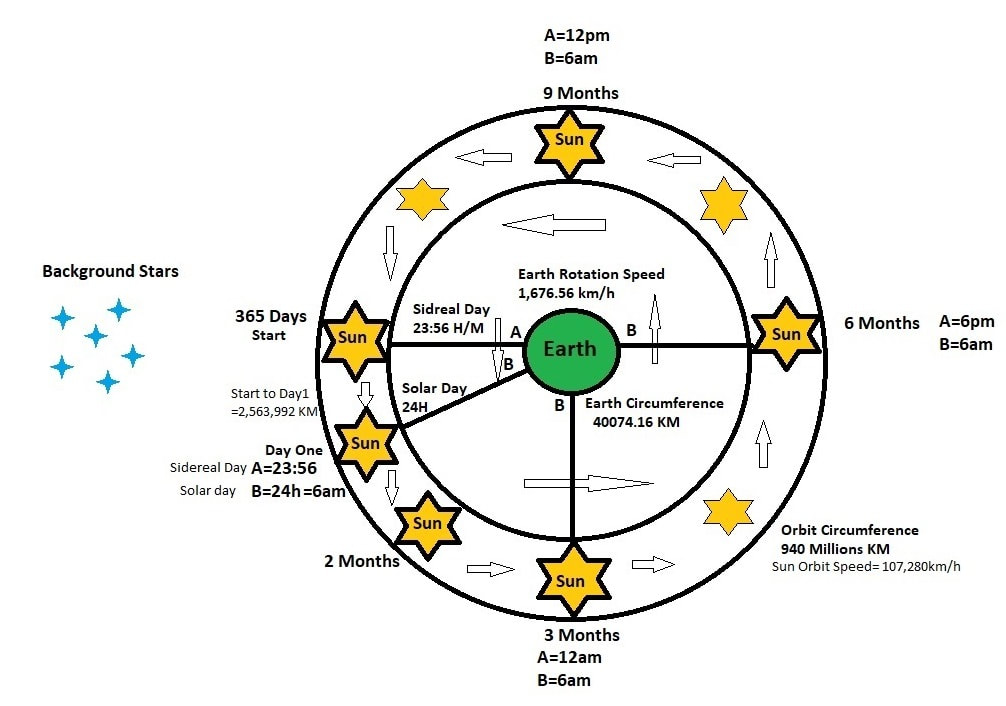The Geocentric Model vs. the Heliocentric Model
Based on the current statistics, the earth rotate around its axis once every 23.9 Hours at speed of 1676.56 km/h, and the circumference of the earth is 40,074.16 km.
The Earth orbit the sun in 365.25 Days at speed of 107,280 km/h, and the circumference of this orbit is 940 Millions/km.
Linking the above statistics, we realize that the earth is finishing a complete one rotation in 23 hours and 56 min, by −4 minutes every day of the length of the day which is 24 Hours.
For example, if today the sun rise at 6 am at certain location on the earth, tomorrow the sun will rise at 6 am −4 minutes at the same location, same scenario every day by −4 min.
Let’s apply the explained fact in to the heliocentric model as below in:
The Earth orbit the sun in 365.25 Days at speed of 107,280 km/h, and the circumference of this orbit is 940 Millions/km.
Linking the above statistics, we realize that the earth is finishing a complete one rotation in 23 hours and 56 min, by −4 minutes every day of the length of the day which is 24 Hours.
For example, if today the sun rise at 6 am at certain location on the earth, tomorrow the sun will rise at 6 am −4 minutes at the same location, same scenario every day by −4 min.
Let’s apply the explained fact in to the heliocentric model as below in:
If we consider the current solar system methodology that the earth orbiting the sun, we will end up with that at same location of the above example, the sun will rise some time at 12 am and some time will set at 12 pm, or some time will rise at 4 pm and will set at 4 am, Likewise onwards all the year, and this is never happened at the history of the human been or at the time of the earth creation. So the Heliocentric model is not applicable with the above data, as the earth speed not matching the day length (Solar Day), which is aligned with the sun rising and set, and led to 24 Hours duration as per to the time invention .
Geocentric is the only model can match the above data and keep the balance for the day time (24 Hours), with + or − 2 to 3 Hours for the sun rise between the winter and summer in the average of the earth locations (Equatorial line for example). By applying the above data, the Sun will orbit the earth at the same circumference of 940 Millions/km at the same speed of 107,280 km/h which was considered for the earth.
The earth rotate around its axis once every 23.9 Hours at speed of 1041 mph (1676.56 km/h), and the circumference of the earth is 40,074.16 km. To maintain the −4 minutes different of the rotation speed with the day length (24 Hours) the sun will move over its orbit: ((107,280 km/h) × 23.9 h) = 2,563,992 km.
So the earth rotation speed must be aligned with the sun orbit speed per day, and by applying the below equation:
Earth circumference × Sun orbit speed = Sun Daily movement distance × Earth Rotation Speed.
Applying the data to the equation:
Earth Rotation Speed = 1676.74 km/h. And this is the recent record of the earth rotation speed.
The below Figure will explain the applied data.
Geocentric is the only model can match the above data and keep the balance for the day time (24 Hours), with + or − 2 to 3 Hours for the sun rise between the winter and summer in the average of the earth locations (Equatorial line for example). By applying the above data, the Sun will orbit the earth at the same circumference of 940 Millions/km at the same speed of 107,280 km/h which was considered for the earth.
The earth rotate around its axis once every 23.9 Hours at speed of 1041 mph (1676.56 km/h), and the circumference of the earth is 40,074.16 km. To maintain the −4 minutes different of the rotation speed with the day length (24 Hours) the sun will move over its orbit: ((107,280 km/h) × 23.9 h) = 2,563,992 km.
So the earth rotation speed must be aligned with the sun orbit speed per day, and by applying the below equation:
Earth circumference × Sun orbit speed = Sun Daily movement distance × Earth Rotation Speed.
Applying the data to the equation:
Earth Rotation Speed = 1676.74 km/h. And this is the recent record of the earth rotation speed.
The below Figure will explain the applied data.
The above figure explain how the Geocentric model works with calculation of the time and the distance taking for the Sun to orbit the Earth, also how the Sun maintain the timing between the Solar Day and the Sidereal Day.
In the other chapter, I explained the role of the Religion in Astronomy, and how the heavenly books discuss these theories for the Beginning of the Universe.
In the other chapter, I explained the role of the Religion in Astronomy, and how the heavenly books discuss these theories for the Beginning of the Universe.


